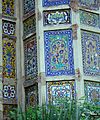Chauburji
چو برجی | |
C.E. |

Chauburji (
Overview
Chauburji is located on Lahore's
History

The establishment of this garden is often attributed to
Lost Mughal garden
The garden for which Chauburji acted as a gateway no longer exists, and the structure is now located in a grassy roundabout at the busy intersection of Lahore's Multan Road, and Bahawalpur Road. The Mughal garden is believed to have extended from Nawankot in the south, and extending towards Lahore city.[1]
Flooding from the
1960s renovation
During a severe earthquake in 1846, the north-western minaret collapsed and cracks appeared in the central arch. This has however been restored as much as was reasonably possible and the gateway now looks quite as it might have been during the time of its Mughal patroness. The restoration was carried out by the Department of Archeology, Government of Pakistan in the late 1960s.[1]
Impact of Metro construction
The Chauburji monument is situated along the planned route of the Orange Line of the Lahore Metro. Heritage campaigners submitted a petition to the Lahore High Court as the planned metro line will pass close to Chauburji, Shalimar Gardens, and nine other sites in the city in violation of the Punjab Special Premises Ordinance, 1985 and Antiquity Act, 1975.[3] In August 2016, the Court halted construction of the metro within 200 feet of any heritage site, including Chauburji in order to prevent what UNESCO termed as potentially "irreversible damage", were the line to be constructed in its present form.[4] The Chauburji station was originally planned to be underground, but it was changed to an elevated station to comply with the UNESCO regulations.
Architecture

Chauburji is built in a
The eastern and western facades of the structure are decorated by two-storey Timurid-style
The building's red brickwork is typical of the Muslim buildings of the sub-continent; the doorways and windows running through the interior corridors are examples of the living style that characterised Mughal structures. Although most of the inscriptions on Chauburjia have been lost, on the upper-most part of the construction
It has been suggested that the Charminar of Hyderabad, India influenced the architecture of Chauburji.[5]
Conservation
Chauburji is listed on the Protected Heritage Monuments of the Archaeology Department of Punjab.[6]
Gallery
-
An example of Chauburji's Persian-style tilework.
-
Embellishments on the Chauburji minaret
-
Detail on Chauburji minaret
-
A view of the monument
-
A view of Chauburji's minarets with tile work
-
Lahore after rainfall
-
View of Chauburji
-
Chauburji roundabout in 2014
See also
References
- ^ a b c d e "Chauburji Gate, Lahore, Pakistan". Asian Historical Architecture website. Retrieved 12 November 2020.
- ^ a b c Sana Munir (30 June 2019). "Jehan Ara's Chauburji". The News International (newspaper). Retrieved 19 November 2020.
- ^ "LHC suspended construction of Orange Line Metro Train". Pakistan Tribune. 19 August 2016. Retrieved 18 November 2020.
- ^ Jon Boone in Islamabad (19 August 2016). "Lahore court backs heritage challenge over metro plans". The Guardian. Retrieved 18 November 2020.
- ^ Daniyal Saleem Gilani (14 November 2001). "DAWN - Features; November 14, 2001 (scroll down to read 'Our own Char Minar' (Chauburji monument)". Dawn (newspaper). Retrieved 11 November 2020.
- ^ Pakistan Environmental Protection Agency (23 May 2005). "Guidelines For Sensitive And Critical Areas, Government of Pakistan (October 1997)" (PDF). Government of Pakistan website. pp. 12, 47, 48. Archived from the original (PDF) on 14 October 2013. Retrieved 12 November 2020.








